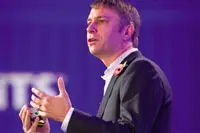 In his keynote address to NIDays, held last week in London, Eric Starkloff, vice president of global sales and marketing for National Instruments, said the Internet of Things (IoT) was not so much a technology, but more a 'convergence of technology'. He identified four main contributors: Moore's Law; wireless connectivity; sensor technology; and networking.
In his keynote address to NIDays, held last week in London, Eric Starkloff, vice president of global sales and marketing for National Instruments, said the Internet of Things (IoT) was not so much a technology, but more a 'convergence of technology'. He identified four main contributors: Moore's Law; wireless connectivity; sensor technology; and networking.
Applications, Starkloff continued, could be split into two main areas: industrial, including smart factories, smart machines and smart cities; and consumer, such as wearables, smart TVs and smart homes.
He then went on to talk about the test solutions needed to make the IoT a a reality, before handing over the stage to Ian Bell, NI's engineering group leader, who introduced delegates to the world's first reconfigurable oscilloscope.
"When we set out to design this new oscilloscope, we wanted to start from the ground up," Bell noted. "Most oscilloscopes on the market today work like products common in the 1980s. They take snapshots of a signal and post process the data to find specific trigger conditions. During the 'dead times' between snapshots, the oscilloscope can miss triggers, making it more difficult to find problems in your design and resulting in longer test times.
"In our new oscilloscope we take a different approach; the FPGA is in the digital data path right behind the A/D converter, processing every data point continuously."
Another hot topic which NI was keen to discuss at the event was skills. The company's academic director Dave Wilson told delegates about NI's efforts to make sure graduates are ready for the workplace. "Skills learned in the classroom, paired with platforms that scale to industry, are what will prepare students to solve the grand challenges of tomorrow," he stressed.
Also tackling the subject of skills and grand challenges was NI's technical marketing manager Richard Roberts, who used the last keynote of the day to talk about issues such as healthcare, sustainability, urban infrastructure and security. Roberts said it was 'critical' to prepare the next generation of innovators if feats like engineering better medicine, providing energy from fusion and reverse engineering the human brain are ever to be achieved.
Author
Laura Hopperton
Source: www.newelectronics.co.uk
